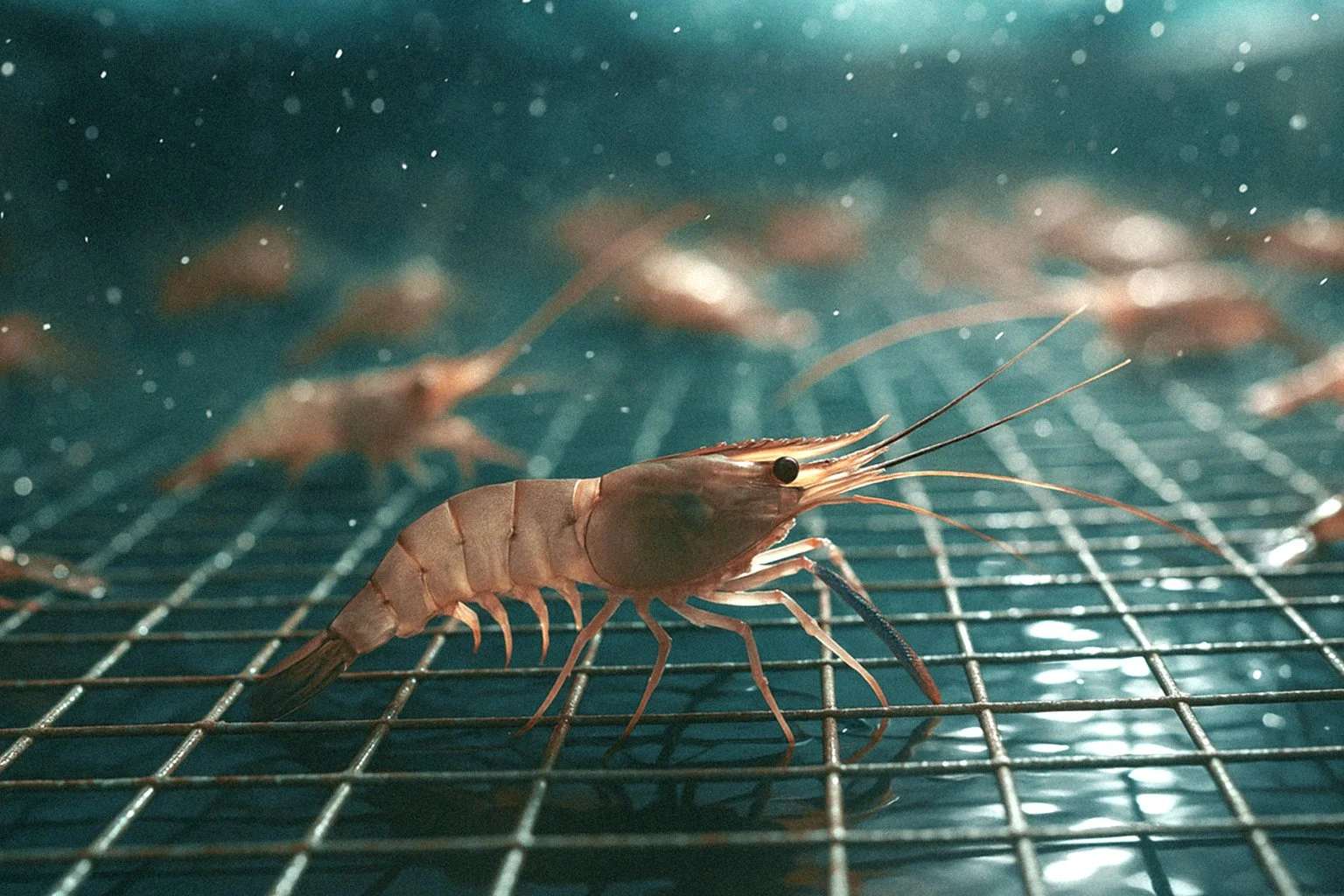
Novel Shrimp Vaccine.
In Development.
Dalan’s shrimp vaccine under development aims to be a sustainable, non-chemical alternative to combat devastating diseases such as White Spot Syndrome Virus (WSSV) and Early Mortality Syndrome (EMS)
The global farmed shrimp
market is projected to exceed
$100 billion by 2032
Farmed shrimp has become one of the world's most sustainable forms of protein production, offering exceptional feed conversion efficiency and requiring significantly less land and freshwater resources compared to traditional livestock. Despite the projected growth, disease remains a major challenge, with 20–40% of farmed shrimp lost annually. One of the most prevalent threats is White Spot Syndrome Virus (WSSV), which continues to cause significant economic and production losses across the industry. Southeast Asia (SEA) is the world's largest region for exporting shrimp.
-
Approximately 80% of global production of farmed marine shrimp are produced in Asian/Southeast Asian countries including Vietnam, Indonesia, Thailand, India, and the Philippines, equalling close to 2 million ton per year making the region the world's dominant shrimp production hub.
-
The Southeast Asian (SEA) shrimp industry is heavily export-focused, with domestic consumption accounts for only 5-20% while foreign markets absorb 80-95% of total farmed production. SEA shrimp farms primarily serve affluent markets in Japan, the USA, and Europe.
-
Disease outbreaks have caused massive economic losses, with recent estimates putting losses at US$6 billion per year caused mainly by white spot syndrome virus (WSSV), early mortality syndrome (EMS) and other diseases. These have repeatedly caused production crashes across major producing countries, making disease management one of the industry's greatest challenges.
White Spot Syndrome Virus (WSSV)
Farmed shrimp are particularly vulnerable to White Spot Syndrome Virus (WSSV) during the first 15 to 50 days of production. WSSV is a highly lethal virus that causes white spot disease, which can lead to the rapid death of juvenile shrimp and post-larvae.
In newly infected populations, visible clinical signs are quickly followed by high mortality rates, which can reach up to 100% within just 3 to 10 days. It is estimated that WSSV is responsible for the loss of approximately 15% of global shrimp production.
Controlling WSSV benefits the entire ecosystem and reduces disease pressure on wild shrimp populations.
Early Mortality Syndrome
(EMS)
Early Mortality Syndrome (EMS), also known as Acute Hepatopancreatic Necrosis Disease (AHPND) is a devastating bacterial disease caused by Vibrio parahaemolyticus affecting farmed shrimp. The disease is characterized by high mortality rates, often exceeding 70%, and is typically observed within the first 30 days after stocking.
The Solution:
Dalan's Shrimp Vaccine
Dalan’s shrimp vaccine under development aims to be a sustainable, non-chemical alternative to combat devastating diseases such as White Spot Syndrome Virus (WSSV) and Early Mortality Syndrome (EMS)
-
Innate immunity, once believed to lack memory, can now be trained—opening up new possibilities for disease prevention.
This breakthrough forms the basis of a proven platform technology that has already been successfully applied in honeybees and is now being expanded to protect shrimp.
-
Significant reduction in mortality was observed in post larvae shrimp exposed to either White Spot Syndrome Virus (WSSV) or Vibrio parahaemolyticus, the cause of Early Mortality Syndrome (EMS).
Novel vaccination concept, administered via the broodstock.
Non-GMO, non-chemical solution with the potential to reduce reliance on antibiotics and chemical treatments.
-
Reduces economic losses in shrimp farming caused by infectious diseases.
Enhances biosecurity measures, preventing disease spread across global aquaculture.
Supports global efforts to reduce antibiotic use, combating antimicrobial resistance.

Vertical Shrimp
Farming Process
(1)Broodstock and Hatchery
This stage involves breeding adult shrimp and producing larvae (nauplii).
(2)Nursery
The nauplii are transferred to nursery tanks or ponds where they grow into postlarvae (PL).
(3)Grow-out Ponds
The PL are then moved to larger ponds where they are raised to market size.
(4)Harvesting
The shrimp are harvested from the ponds using nets or pumps.
(5)Processing and Packaging
The harvested shrimp are processed, packaged, and prepared for distribution.
Dalan's Shrimp
Production Advisory Board
-
Owner of Gluna Shrimp and co-founder of the Global Shrimp Council, Mr. Luna advises international seafood buyers and has extensive experience in shrimp farming, sales, and exports across Ecuador, France, Italy, and Asia
-
Former Assistant Director at Ernst & Young, Ms. Tsang has investment banking and life sciences research experience, including drug discovery at Abbott Laboratories. She holds an MBA from Cambridge and a BS in Biochemistry from Seattle University.
-
A professor and consultant specializing in Indigenous aquaculture, fish welfare, and industry innovation. Dr. Kadri has introduced disruptive technologies like demand feeding systems and biotech solutions to intensive aquaculture.
Interested in learning more about Dalan's innovative shrimp vaccine solutions? Contact our team today to discuss how our technology can help protect your shrimp operations.


Shrimp Vaccine
Frequently Asked Questions
How does the vaccine work?
The vaccine works via a biological phenomenon known as Transgenerational Immune Priming (TGIP). The vaccine, containing a killed pathogen, is administered to the maternal broodstock.
How is the vaccine administered?
It is administered by exposing the maternal broodstock (parent shrimp) to the vaccine.
Can the vaccine be combined with food in ponds?
No, at this time, this is not an effective method to vaccinate.
How long does the vaccine last?
As the vaccine is still in development, this is still to be determined.
When will the vaccine be available?
The vaccine is in development, and we aim to make it available subject to regulatory approval.
Additional Resources












